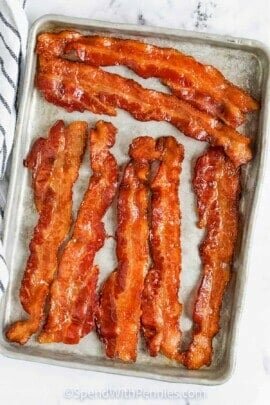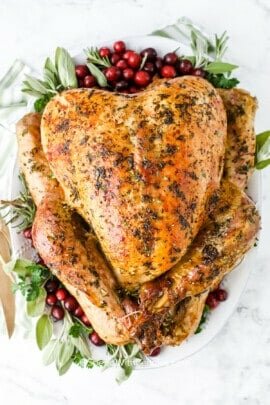Fresh vs Dried Herbs don’t have to cause confusion. If your recipe calls for dried herbs and you only have fresh – or vice versa – don’t despair!
Most grocery stores now have a nice selection of both fresh and dried herbs. But when it comes to choosing between fresh and dried herbs it all depends on which herb we’re talking about and its intended use. For salads and uncooked dishes, strive to use fresh when possible, likewise for garnishes. For those long-simmering soups or stews, dried is the better choice.
But rarely do you use all the fresh herbs right away, so you’ll need a way to preserve them for future use. You can either dry them or extend their shelf life following these easy steps below.
How Much Dried to Replace Fresh
Dried spices have the water removed and are stronger in flavor, you will need about 1/3 the amount dried as you would for fresh. This will vary somewhat but as a general rule:
If a recipe calls for 1 teaspoon dried, add 1 tablespoon fresh herbs
This is a general guideline and can vary based on the type of herb/spice.
Are Dried Spices Stronger Than Fresh?
Again, it depends on the herb, not to mention how long it’s been sitting in your cupboard (while I often keep mine longer than 1 year, it’s true that they do lose flavor so I try not to keep them much longer than that)! Any dried herb or spice will start losing flavor after a while, as the aromatic oils deteriorate.
Experts say discard after a year, but I don’t know many cooks who do that, myself included! I just add a little more than the recipe calls for if it seems warranted. After a couple of years, yes, those dusty remnants get tossed.
- Herbs that Increase Flavor when dried: Many herbs intensify and improve when dried. Among these: oregano, marjoram, rosemary, thyme, bay, and sage. These guys are definitely stronger in their dry state.
- Herbs that Lose Flavor when dried: Others like parsley, chives, dill weed, and curry leaves lose flavor and develop off-putting grassy notes when dried. Try to use these in their fresh state when possible. Many cooks say the same thing about basil. Although I agree in general, I personally prefer the flavors that dried basil gives to tomato-based sauces, more than fresh.
Cilantro leaves are downright useless when dried, so don’t even attempt it. Cilantro seed meanwhile, which is known as coriander, is always dried and ground. Likewise, cumin seeds are packaged either whole or ground up into a powder.
How to Dry Fresh Herbs
Drying fresh herbs is so easy, and it’s good for your wallet too. Fresh herbs come in plastic clamshell packaging to help retain the moisture for as long as possible in the store. Here’s what you should do when you get them home.
- Remove them from their packaging and sort out any dead leaves or stems.
- Insert them into a small paper bag with the cut ends sticking out. Lunch bags are a perfect size.
- Bundle the stems and the edges of the bag with a rubber band so the bag forms a balloon.
- Hang upside down to dry for several days.
The bag will catch any leaves that fall off, and because it’s paper, will allow the herbs to dry. When your herbs are dry, you can rub the stems inside the bag to make the rest of the leaves fall off. Place the dried leaves in an airtight container, and you’ll have herbs at the ready for the next time you’re cooking.
How to Substitute Fresh vs Dried Herbs and Spices
The main thing to remember when converting from fresh to dried and vice versa is that most dried herbs are two or three times more intense than fresh. So just remember that the fresh vs dry herbs conversion is 1:3. For instance, a typical fresh vs dried herbs measurement would be one teaspoon of dried for 3 teaspoons of fresh.
Bear in mind this conversion ratio is just a guideline. Some cooks recommend a two-parts-fresh to one-part-dried, especially if the dried version is powdered. Ginger comes to mind here and is one you’d be wise to substitute carefully. Personally I substitute about ½ teaspoon or less of ground ginger in place of a tablespoon of fresh.
When it comes to herbs, there’s really no right or wrong. As long as you remember that dried herbs are stronger than fresh and let your nose and palate guide you, all your culinary creations should wind up tasting sensational.
How to Store Fresh Herbs
You can extend the life of your fresh herbs by treating them much like a bunch of fresh flowers. You might be amazed at how long they’ll stay fresh by following these simple steps.
- Remove them from their packaging and cut the ends.
- Place the ends in a jar or glass of water, and set on a shelf in your refrigerator.
- Place a plastic bag loosely over the fresh ends.
You can keep many fresh herbs for well over a week this way. Just be sure to check the water and change it as needed. This is a great technique to keep the stems fresh for a few days. You can always take them from fresh to dried herbs later, using the drying technique I’ve described above.
Whether fresh or dried, herbs will always give your dishes an extra layer of flavor and pizzazz, so always keep them handy in your kitchen.
Pantry Staples to Make with Dried Herbs
- Homemade Cajun Seasoning – all-time favorite blend!
- Fajita Seasoning – quick & easy to make
- Italian Seasoning – great for pasta sauces!
- Chicken Seasoning – fragrant & savory blend
- Homemade Taco Seasoning – control the spice level!


















Thank you for this incredibly useful information. When explaining how to dry herbs, there’s no mention of rinsing them before drying them. Will they get dry enough (like dill) before I bundle them to dry out? Thanks, and thanks for so many great recipes.
If washing them beforehand you will want to pat dry as best as you can and leave them out to air dry for a bit before moving forward with making dried herbs.
thanks